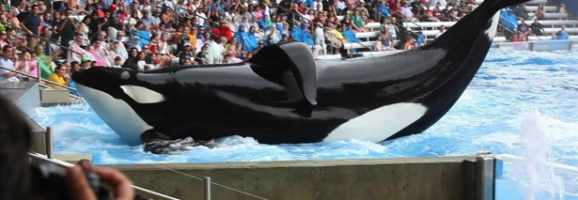Blackfish Review: A Brutal and Necessary Wake-up Call
Much ink has been spilt over Blackfish, the scathing new documentary from Gabriela Coperthwaite that interrogates the SeaWorld enterprise from top-to-bottom. The charge involves the parks’ perennial cash cow: the killer whale, none more spectacular than the 12,000-pound Tilikum. The evidence includes three human deaths at the hands of “Tilly”, most recently (and publicly) the 2010 death of veteran trainer Dawn Brancheau. The witnesses include neuroscientists, fishermen, and former trainers and the jury finds SeaWorld guilty of deceit, corruption, and most severely, the barbaric mistreatment of their main attraction.

So much ink has been spilt over this gut-wrenching film that I was tempted not to contribute to the conversation at all. What could I say, I wondered, that hasn’t already been said. I’m not a scientist or a psychologist, a current or former SeaWorld employee, so who am I to chime in? Well, I love movies and I love whales, so when something bridges two of my passions so directly, my emotional investment skyrockets. Something about the marriage between our biggest, most majestic creature and the majesty of the big screen really gets my juices flowing and “whale scenes” in films like Finding Nemo, Cast Away, and Life of Pi give me goosebumps every time.
What’s more, I grew up in San Diego, home to the world famous San Diego Zoo, the Wild Animal Park (now the San Diego Zoo Safari Park), and of course one of the many SeaWorlds. I grew up accepting the last of these attractions as readily as I did the first two, never considering the difference between protecting endangered species and signing them up for the circus. I remember going to SeaWorld as a kid, marveling at the animals, oohing and ahhing along with the crowd, squealing with delight in the “splash zone”. It didn’t think twice about the implications of confining a creature that swims up to 100mph a day to a glorified swimming pool. It was entertainment. Nothing more, nothing less.
To say that Coperthwaite challenges this illusion of normalcy would be the understatement of the year–she skewers it, roasts it, tears it apart limb from limb. It’s a rare and riveting feat of documentary filmmaking that inspires action and promotes change. If enough people see it, discuss it, and are properly enraged by what they see, SeaWorld will have to respond.
Coperthwaite leaves no stone unturned, stuffing a brief 83 minutes to the gills with powerful testimonies from every possible angle, chronicling Tilikum’s life of captivity from the very beginning. One of the fishermen who captured the orca in the early ’80s fights back tears, admitting that hunting down and removing the baby whale from his mother was the worst thing he ever did. A neuroscientist explains the highly developed orca brain, claiming that they feel emotions deeper than any other animal, including humans. Former employees of the now-defunct SeaLand recall storing “Tilly” in a 20×30 feet, pitch-black “module”, where a psychologist believes a state of “psychosis” took place.

Coperthwaite masterfully passes the baton from subject to subject, each filling in a piece of the puzzle that accounts for Tilikum’s aggression and firmly places the blame (and the blood) on human hands. Part propaganda, part psychological thriller, Blackfish is also a captivating horror story where the villain is not a mutant or a monster (though the poster cleverly echoes the man-eating shark in Jaws), but a multi-billion dollar corporation that hides behind a team of lawyers and a binder full of party-lines. Scarier than the 23-foot killer whale is a company that mechanically sweeps things under the rug, knowingly putting its trainers in harm’s way on a daily basis.
The former trainers are the story’s heroes, victims, and whistleblowers all at once. We sympathize with them because we too were once caught under the spell, so titillated by the SeaWorld experience that we never stopped to realize how fishy it all was. The trainers recall spewing bogus “facts” about orca lifespans and collapsed dorsal fins and they consider with increasing outrage how much information was purposefully kept out of their reach, how little they truly knew about these animals.
For SeaWorld’s side of the story, we need look no further than our TVs, where commercials portray killer whales as harmless puppies with which humans are meant to frolic and play. An orca peers through the glass and gives a little girl fashion advice by shaking and nodding his head–a cute, cuddly captive that once roamed the open ocean but now exists to amuse a child.
Coperthwaite displays spectacular footage of humans interacting with orcas (including some seriously stomach-turning attacks), but she keeps Tilikum at a distance. Don’t expect to see Dawn Brancheau’s death. Was it too gruesome for a PG-13 rating? Was it a lawsuit waiting to happen? Did SeaWorld burn the tape? I suspect that she withheld this last piece of evidence to destroy once and for all the illusion that we can understand and relate to these creatures. It’s this very delusion that led us to believe we can imprison and control whales if we feed them fish.
We can’t. And thanks to Coperthwaite, maybe someday we won’t.
Rating:
What do you think? Leave a comment.











This is a great experience. I highly recommend it. Suggest to anyone to see it with an open mind. You will never see captivity the same way.
I just saw this film. Excellent and infuriating.
Tilikum and the others should be released. At once. It is a great evil to deprive any creature of its dignity, freedom, and right to be included in the society of its own kind, in deference to our desire for profit and entertainment.
We humans are such beasts. Scarely a day goes by when I don’t wish I could trade my DNA for that of a hawk, or some other fine animal. These animals have one great advantage over us: they’ve nothing to blush about.
Well said. I definitely think SeaWorld is the most rampant offender when it comes to sacrificing morals for profit. I’m no expert, but organizations like the San Diego Zoo and the San Diego Zoo Safari Park seem much more justifiable because of their commitment to protect and rejuvenate endangered species. There’s still something amiss seeing such majestic creatures in cages, but as I understand it, several of these animals prefer to form their own kinds of “enclosures” in the wild–hunting, mating, and existing in similarly small areas. The only thing a zoo removes from the equation is the threat of predators and the dangers of starvation. On the other hand, containing a whale that swims up to 100 miles per day in a glorified bathtub seems much more blatant in its cruelty and immorality.
This film is so biased. Yes it is wrong to keep these mammals in captivity but they only keep a very small proportion. The trainers etc know the risks, they choose to work with them because they enjoy doing it. Every job has a risk, there is the same risk dying in a car crash than getting eaten by a killer whale (for a trainer). People enjoy seeing the whales and they do provide them with food etc. I’m not saying it’s right to keep them in captivity but this is film is just very biased.
There are biases to this documentary, as there are in all documentaries, but I feel that the director included enough first-person evidence to support her claims. She not only included testimonies from past and present SeaWorld Trainers (none of whom seem disgruntled for any other reason than animal maltreatment), but she also tracked down eye witnesses to the attacks to offer differing perspectives to SeaWorld’s official statements. I saw the film and thought it was a powerful, well-supported statement of injustice.
Also, the small portion of animals suffering abuse doesn’t justify the actions as right. By that argument, the Holocaust could be morally justified because only a fraction of the earth’s population was brutally imprisoned, tortured, and murdered. Wrong is still wrong, even if only affects one animal or person.
Great article, by interested to see this film now, if not a little nervous!
Inhumane is the word, I’m shocked – shall blog about this!
im in full support of these wales being free and not being kept in captivity in places like Sea World but i have a feeling that this documentary is not going to change anything 🙁 it brakes my heart that these animals a treated like this. i just hope this is enough to open peoples eyes….
Fantastic review of a powerful documentary. SeaWorld is such a corrupt industry and I’m glad that the film is getting the exposure it deserves.
Great review! SeaWorld’s operations may serve the public, but its nothing compared to saving endangered species and seeing animals in their natural habitat. I hope this movie gets a great deal of exposure!
I’ve seen this documentary and it is definitely eye opening to the way these creatures are treated and the way that we look at zoos and theme parks like Sea World. This movie infuriated me but I had to take a step back and realize that this can occur at zoos also and I loved visiting them. It is really eye opening with the way humans interact with animals.
The points are true; having said this, I think the point, based on the review, was that it is less likely to occur at zoos, because the function of zoos is subtlety, but importantly distinguished.
Your closing arguments: right in the feels!